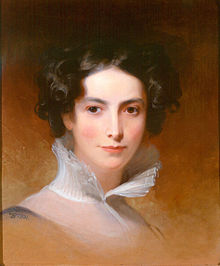Rebecca Gratz
Rebecca Gratz | |
|---|---|
 portrait by Thomas Sully, 1831 | |
| Born | March 4, 1781 |
| Died | August 27, 1869 (aged 88) |
| Resting place | Mikveh Israel Cemetery |
Rebecca Gratz (March 4, 1781 – August 27, 1869) was a Jewish American educator and philanthropist in 19th-century America. She was a member of the Gratz family, who settled in the United States before the Revolutionary War.[1]
Early life[edit]
Rebecca Gratz was born on March 4, 1781, in Lancaster, Pennsylvania. She was the seventh of twelve children born to Miriam Simon and Michael Gratz. Her mother was the daughter of Joseph Simon, a preeminent Jewish merchant of Lancaster, while her father, whose surname originally was Grätz, immigrated to America in 1752 from Langendorf, in German-speaking Silesia.[2] Michael, who was descended from a long line of respected rabbis, and Miriam were observant Jews and active members of Philadelphia's first synagogue, Mikveh Israel.
Philanthropy[edit]
In 1801, at the age of 20, Rebecca Gratz helped establish the Female Association for the Relief of Women and Children in Reduced Circumstances, which helped women whose families were suffering after the American Revolutionary War.[3] In 1815, after seeing the need for an institution for orphans in Philadelphia, she was among those instrumental in founding the Philadelphia Orphan Asylum.[2] Four years later, she was elected secretary of its board. She continued to hold this office for forty years. Under Gratz' auspices, a Hebrew Sunday School, the first of its kind in America, was started in 1838. Gratz became both its superintendent and president and assisted in developing its curriculum,[3] resigning in 1864.
Gratz was also one of the founding members of the Female Hebrew Benevolent Society of Philadelphia in 1819. The social services organization was created by a group of women from Congregation Mikveh Israel to support Philadelphia's Jewish women who found themselves unexpectedly without a husband (whether by illness, death or greener pastures). Gratz held the secretary position in the group for close to 40 years.[4]
In 1850, she advocated in The Occident, over the signature A Daughter of Israel, the foundation of a Jewish foster home. Her advocacy was largely instrumental in the establishment of such a home in 1855.[3] Other organizations that came about due to her efforts were the Fuel Society and the Sewing Society.
Gratz is said to have been the model of Rebecca, the daughter of the Jewish merchant Isaac of York, who is the heroine in the novel Ivanhoe by Sir Walter Scott.[2] Scott's attention had been drawn to Gratz's character by Washington Irving, who was a close friend of the Gratz family.[5][6] The claim has been disputed, but it has also been well sustained in an article entitled "The Original of Rebecca in Ivanhoe", which appeared in The Century Magazine, 1882, pp. 679–682.
Gratz never married. Among the marriage offers she received was one from a Gentile whom she loved but ultimately chose not to marry on account of her faith.
Her portrait was painted twice by the noted American artist Thomas Sully. One of those portraits (both are owned by the Rosenbach Museum) is on display at the National Museum of American Jewish History.[7]
Death[edit]
Gratz died on August 27, 1869, in Philadelphia, Pennsylvania and was buried at Mikveh Israel Cemetery. Shortly after her death, her brother Hyman founded and financed Gratz College, a teachers’ college in Philadelphia, in her memory.
Reference Notes[edit]
- ^ [1]
- ^ a b c Green, David B. (27 August 2013). "This day in Jewish history: Pioneering philanthropist and educator dies". Haaretz.com. Retrieved 4 September 2013.
- ^ a b c Burlingame, Dwight F. (ed.) (2004). Philanthropy in America: A Comprehensive Historical Encyclopedia, Vol. 1, pp. 215-16. ABC-CLIO, Inc. ISBN 1-57607-860-4.
- ^ Bernstein, Jesse (2019-05-20). "Group Helps Jewish Women for 200 Years". Jewish Exponent. Retrieved 2019-05-23.
- ^ "Ivanhoe" Legend Rebecca Gratz, 1781 – 1869 Archived 2010-11-05 at the Wayback Machine - entry in the Jewish Women's Archive (retrieved 2010-9-25)
- ^ Judith Mindiy Lewin: Legends of Rebecca: Ivanhoe, Dynamic Identification, and the Portraits of Rebecca Gratz Archived 2011-07-06 at the Wayback Machine. In Nashim: A Journal of Jewish Women's Studies & Gender Issues, Number 10, Fall 5766/2006, ISSN 0793-8934
- ^ “Portrait of Rebecca Gratz” by Thomas Sully (1831), Rosenbach Museum.
External links[edit]
- “Rebecca Gratz” by Dianne Ashton at The Shalvi/Hyman Encyclopedia of Jewish Women, Jewish Women's Archive.
- Biography of Rebecca Gratz at the Jewish Virtual Library
- “Rebecca Gratz: Champion of the Unfortunate” by Yitzchok Levine. “Glimpses Into American Jewish History,” The Jewish Press, November 30, 2006.
- Jewish Encyclopedia: “Rebecca Gratz” of the family “Gratz,” by Joseph Jacobs, Elvira Solis, Cyrus Adler & Frank Vizetelly (1906).
- Letters of Rebecca Gratz, edited by David Philipson. Jewish Publication Society of America, 1929.
- Rebecca Gratz at Find a Grave
- Eternal Light radio dramatization of Gratz's life (.mp3 audio file)
- 1781 births
- 1869 deaths
- American people of English-Jewish descent
- American people of German-Jewish descent
- Franklin & Marshall College alumni
- Educators from Philadelphia
- Writers from Philadelphia
- 19th-century American women educators
- Jewish women writers
- 19th-century American women writers
- 19th-century American philanthropists
- Jewish women philanthropists
- American women philanthropists
- 19th-century American educators
- 19th-century women philanthropists
- Hebrew Benevolent Society
